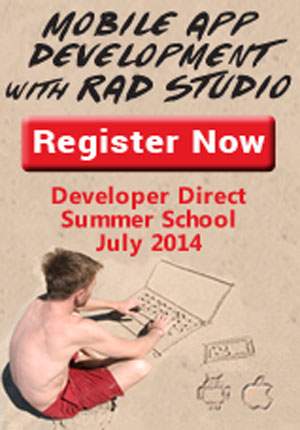Pridružite nam se u ovoj interaktivnoj školi koja će kroz 6 lekcija obraditi razvoj aplikacija za Android i iOS
Zašto bi trebali pohađati ovu školu?
- naučite osnovne sposobnosti potrebne za razvoj Android i iOS aplikacija pomoću RAD Studio, C++Builder ili Delphi XE6 alata.
- naučite razlike između mobilnog i desktop razvoja
- istražite koncepte višeslojnog razvoja u mobilnom kontekstu
- naučite kroz praktične primjere i zadatke.
Lekcije sadrže:
- Hello World! moja prva aplikacija za više platformi
- uključivanje stilova i podataka
- pristup lokalnoj pohrani
- izrada snažnih višeslojnih aplikacija za različite platforme
- povezivanje mobilnih i desktop aplikacija koristeći App Tethering
- izgradnja i korištenje REST i BaaS Cloud servisa
Polaznici trebaju imati trial ili kupljenu verziju RAD Studio, C++Builder ili Delphi XE6 alata kako bi mogli sudjelovati u praktičnom radu. Svi ostali materijali i dokumentacija će biti osigurani.
Raspored lekcija:
| Date | Topic |
| July 7 | Lesson 1 – Hello World! – My First Multi-Device App In this lesson, you will create your first mobile application. Learn how to get your IDE (Integrated Development Environment) set up, configured and ready for the rest of the series. The homework for the lesson is to follow the example on the resource links to build your first “Hello World” application on iOS and Android. |
| July 9 | Lesson 2 – Turning up the Style and Data! In lesson 2, we explore how to style controls in your iOS and Android application, start to work with data and manage the link between user interface and model/data. This session will also explore more components and discover the concept of Interfaces and learn how they help you make your code multi-platform ready. Then, we will look at how to use Interfaces in our applications to write code that will work on multiple devices. |
| July 14 | Lesson 3 – Accessing Local Storage In this lesson, we explore local storage covering a range of options including using INI files, local document storage, and in-memory datasets that can be persisted to local storage using FireDAC’s FDMEMTABLE component. This lesson will also show how to use FireDAC database access components to connect to and use local SQLite, InterBase IBLite and IBToGo. You will understand the core concepts when writing and reading from disk on iOS and Android. |
| July 16 | Lesson 4 – Building Powerful Multi-tier, Multi-device Applications This lesson will show you how to create multi-tier applications (in some cases with zero lines of code) that work with your mobile applications. In this lesson, you will learn how to create middle-tier server applications containing business logic and access to remote enterprise SQL databases. This lesson will also show you how to use the same MastSQL.GDB database in the middle-tier for access and updating, update client information from the mobile app, update customer orders, etc. in the mobile client that serves data to iOS and Android devices. |
| July 21 | Lesson 5 – Connecting Mobile and Desktop Together using App Tethering In lesson 5, you’ll learn how to give your applications the ability to interact with other applications running on a combination of mobile and desktop machines over a subnet or on the same device/computer. You’ll learn how to use app tethering to: 1) Discover other applications that are using app tethering running either on the same device as your application or on other connected devices; 2) Run actions remotely, and; 3) Share data between applications. App tethering allows sharing of standard data types and streams. The mobile app will be able to get Inventory data, update it and call a desktop client application to update the inventory using desktop app actions. This demo will show how to manage inventory in the mobile client sending updates to a desktop app that updates the inventory table in the database. |
| July 23 | Lesson 6 – Building and Accessing REST and BaaS Cloud Services In the previous session, you learned how to build scalable multi-tier applications using mobile clients for iOS and Android. REST and JSON are the common architectures used for multi-tier development. In this final lesson, you will learn how to connect your mobile applications to cloud services using the REST client libraries and the BaaS (Backend as a Service) components for Parse and Kinvey. |
Za više informacija i registraciju kliknite ovdje.
Trial verziju alata možete besplatno nabaviti ovdje.




